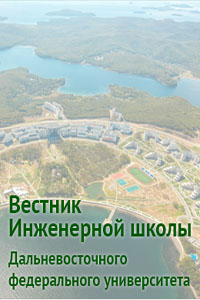Modeling of the transition section of a railway track with and without ballast structures
DOI:
https://doi.org/10.24866/2227-6858/2025-1/18-26Keywords:
railway track, residual deformation, section of variable rigidity, track draft, slope, elastic waveAbstract
The current development of the country's transport systems and individual settlements is associated with the construction of new and reconstruction of existing railway tracks. The articulation of various types of railway track structures is a "weak point" both from the point of view of calculating the elements of the upper structure of the track according to the limiting conditions of the first and second groups, and from the point of view of the source of noise and vibration due to the stiffness difference of the base. The article is devoted to the development of a mathematical model of a railway track during the transition from a ballast track structure to a ballast-free one, in order to ensure the smooth movement of rolling stock, and also make it possible to predict the choice of material and type of base structure. The solution being developed is aimed at creating a double algorithm, which can be used to calculate different cases of articulation of different path structures. The proposed solutions can be generalized to a railway track laid through artificial structures.
References
1. Фазилова З.Т. Влияние анизотропных свойств верхнего строения железнодорожного пути на параметры динамической осадки предмостовых участков // Мир транспорта. 2023. Т. 21, № 3(106). С. 50–58. DOI: https://doi.org/10.18720/MCE.76.11
2. Локтев А.А., Бучкин В.А., Виноградов В.В. Модели взаимодействия колеса и рельса при высоких скоростях движения // Мир транспорта. 2016. Т. 14, № 1(62). С. 54–60. EDN: VWEIAJ
3. Смирнов В.Н., Шестакова Е.Б., Чижов С.В., Антонюк А.А., Ледяев А.П., Индейкин А.В., Евтюков С.А. Динамическое взаимодействие высокоскоростных поездов с пролётными строениями и гибкими опорами // Инженерно-строительный журнал. 2017. № 8(76). С. 115–129. DOI: https://doi.org/10.18720/MCE.76.11
4. Сычева А.В. Управление жёсткостью пути на переходных участках // Путь и путевое хозяйство. 2021. № 2. С. 16–20. EDN: BDXXXI
5. Шехтман Е.И., Черняева В.А., Чупырин А.А., Наумов А.В. Переходные участки бесстыкового пути, примыкающие к стрелочным переводам // Бюллетень результатов научных исследований. 2024. № 3. С. 73–82. DOI: https://doi.org/10.20295/2223-9987-2024-03-73-82
6. Кругликов А.А., Ермолов Я.М., Хакиев З.Б., Окост М.В., Явна В.А. Оценка воздействия подвижного состава на переходные участки железнодорожного пути переменной жёсткости // Транспорт: наука, образование, производство: труды международной научно-практической конференции. Ростов-на-Дону, 12–15 апреля 2016 г. Т. 4. Ростов-на-Дону: Ростовский государственный университет путей сообщения, 2016. С. 78–82.
7. Шаповалов В.Л., Лазоренко Г.И., Явна В.А., Холодный З.В., Дорошкевич А.А. Расчёт конструкции сопряжения участков пути с различной жёсткостью // Путь и путевое хозяйство. 2013. № 12. С. 12–14. EDN: RWTQFF
8. Иванова К.И., Колос А.Ф., Ван С. Упругие характеристики подрельсового основания безбалластного железнодорожного пути // Транспорт БРИКС. 2023. Т. 2, № 1.
DOI: https://doi.org/10.46684/2023.1.4
9. Chattopadhyay S. Permanent indentation effects on the impact response of elastic plates // Journal of the Acoustical Society of America. 1987. Vol. 82, Iss. 2. P. 493–497. DOI: https://doi.org/10.1121/1.395450
10. Ашпиз Е.С., Замуховский А.В., Шмаков А.П., Салмин А.О., Кузнецова А.В. Исследование армирования защитного слоя плоской георешёткой // Современные проблемы проектирования, строительства и эксплуатации железнодорожного пути: труды XIV Международной научно-технической конференции. Чтения, посвящённые памяти профессора Г.М. Шахунянца. Москва, 05–06 апреля 2017 г. Москва: МГУПС, 2017. С. 112–115. EDN: XPQQXJ
11. Шапран В.В. Проектирование и реконструкция участков пути с переменной жёсткостью // Внедрение современных конструкций и передовых технологий в путевое хозяйство. 2013. Т. 6, № 6(6). С. 124–131. EDN: WTPPUX
Downloads
Published
Issue
Section
License
Copyright (c) 2025 Far Eastern Federal University: School of Engineering Bulletin

This work is licensed under a Creative Commons Attribution 4.0 International License.

